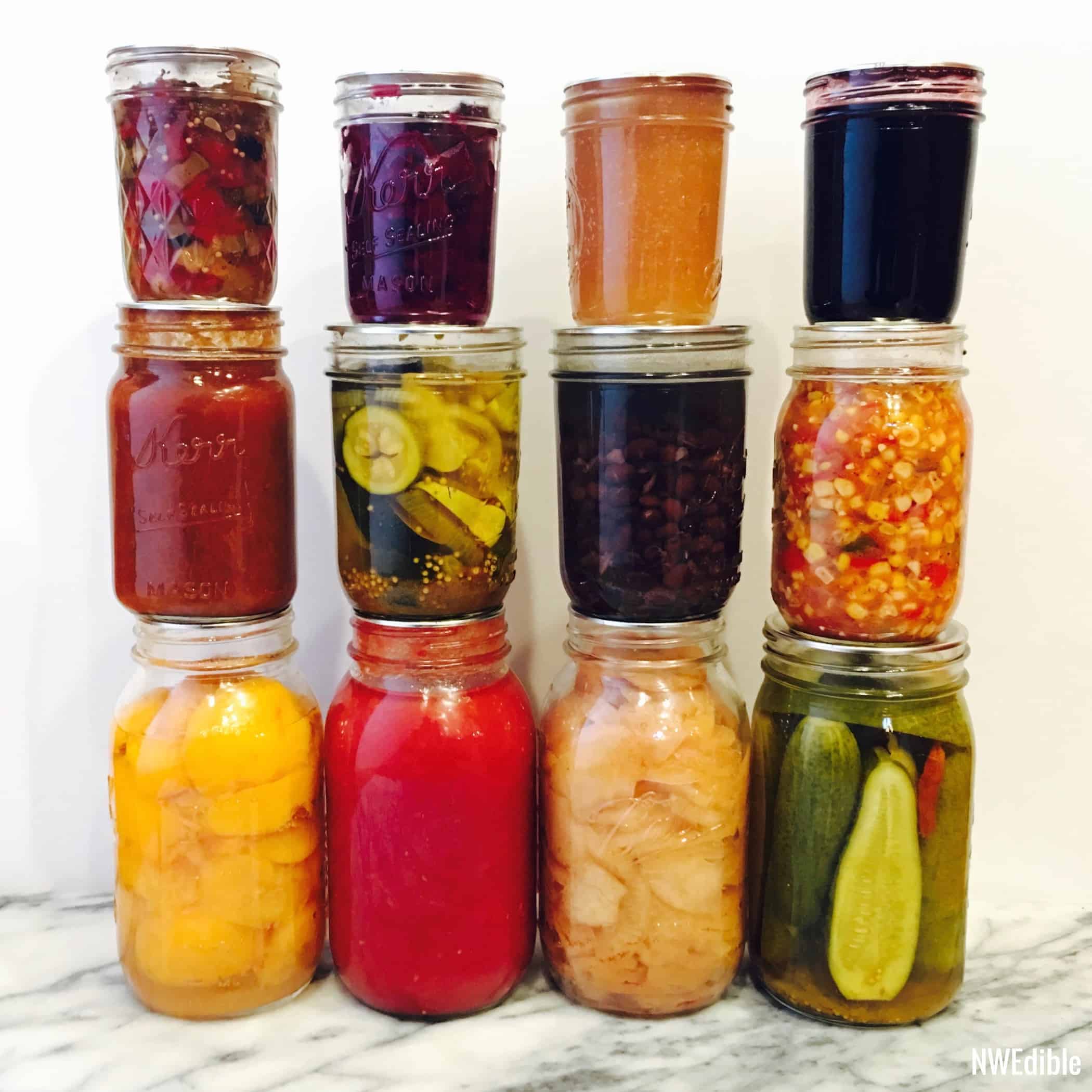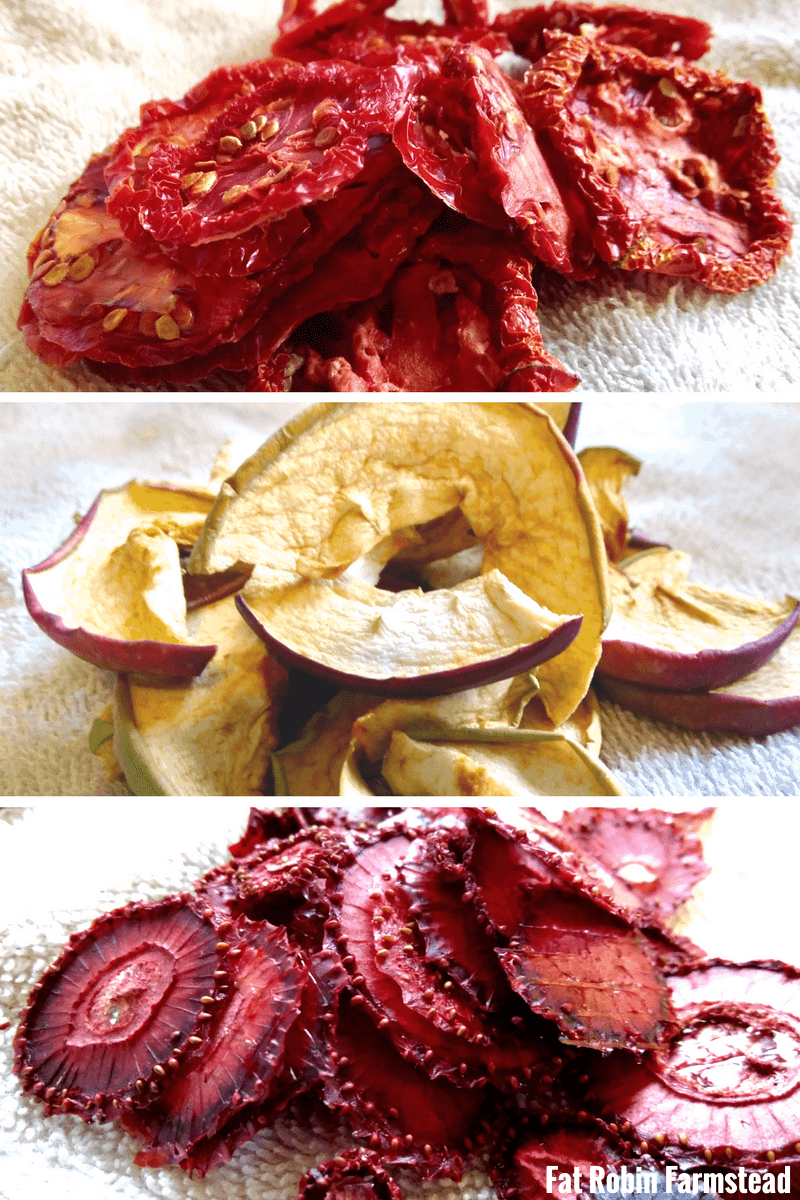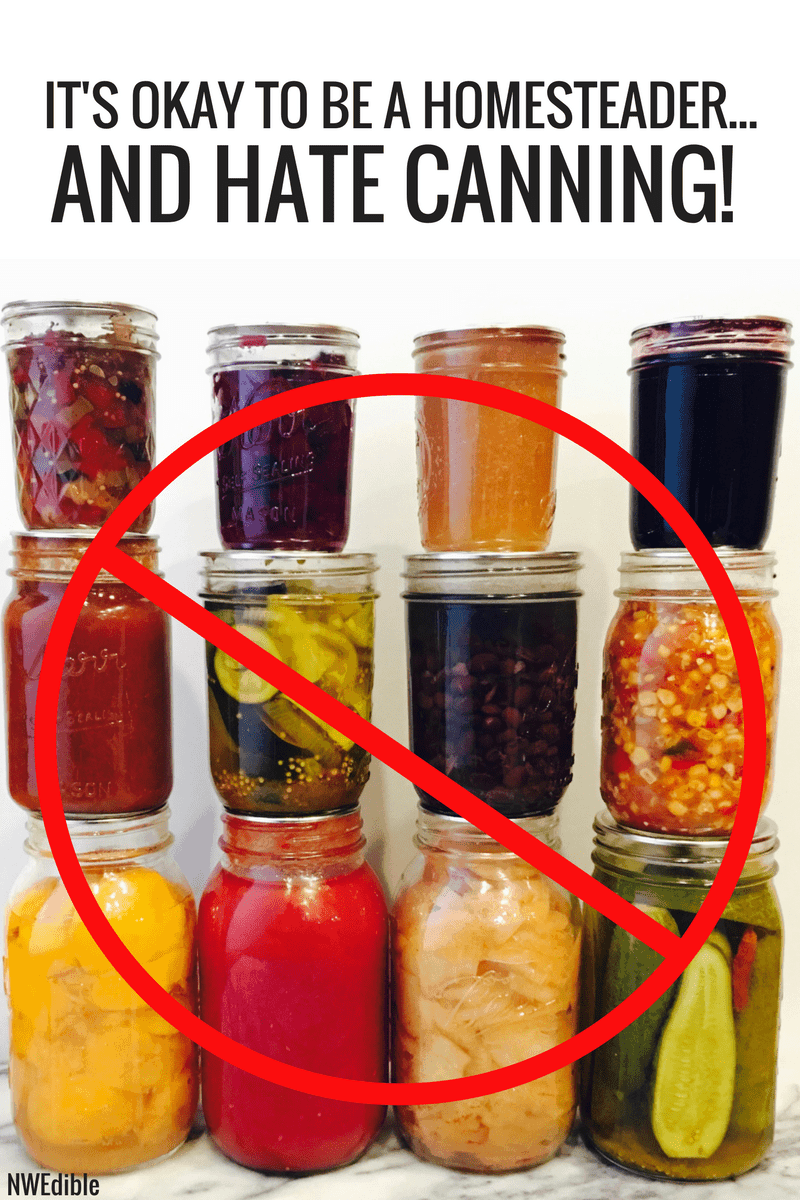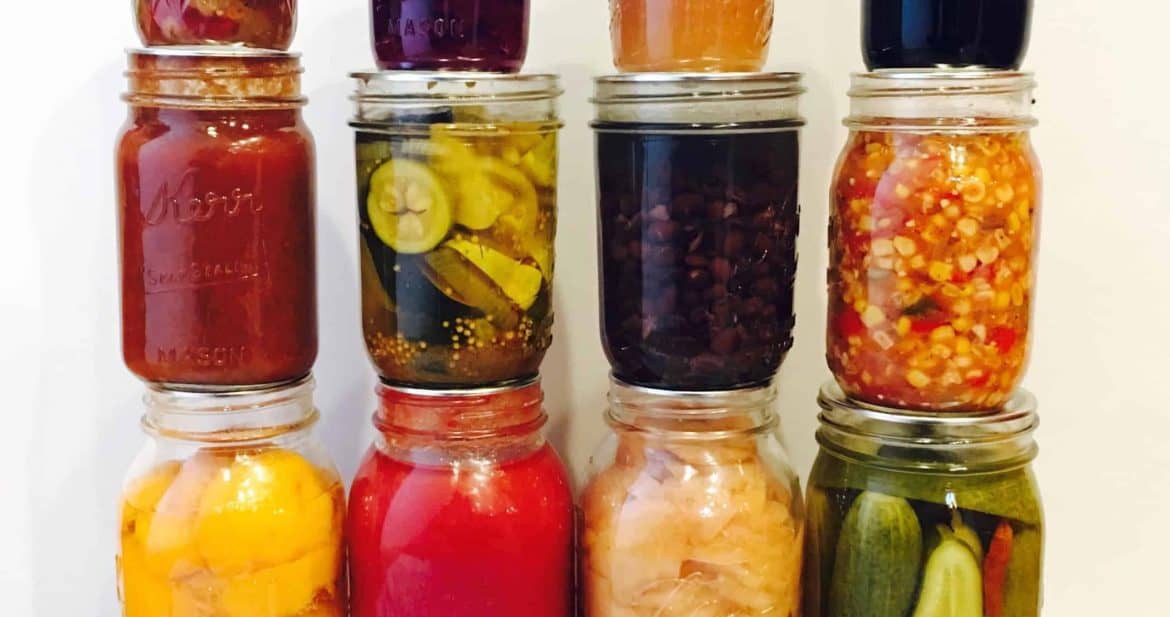Canning is practically synonymous with homesteading. When people see or hear how big my garden is, the first question asked is usually “Oh, you must do a lot of canning, right?” Erica clearly loves to can, and is a great resource for general safety and lots of recipes.
But there are a lot of ways to preserve food, and I’m here to tell you that it’s okay to hate canning. We’re not going to take your homesteader card away if you admit it!
You Must Not Be Doing It Right
Trust me, I know how to can. I have a giant 8 gallon brew kettle purchased to water bath can without getting constantly sprayed by boiling water like with the awful graniteware canning pots. I once owned an All-American pressure canner (sold it to purchase a second Excalibur). I have an awesome Squeezo food mill. I have lots of customized jam recipes (primarily adjusting for zero or low-added sugar).
I’ve invested a few years into learning the ins and outs of canning, and I still continue to can a few things, mostly jams for my kids to eat over the winter and to give away as gifts. I’ve got high enough on the learning curve that the process wasn’t overwhelming.
But the more I thought about canning, the more I hated it. It felt weird to admit it at first, but this year I’ve done almost no canning and I’ve never been happier.
Here are all the reasons I hate canning, and what I’ve come to prefer instead.
Nutrient Density
The first reason for my canning hatred came when I began to learn about the nutrient density of preserved foods. Canning is shelf stable, but it’s also the least nutritious way to preserve food. It is fine for things primarily used as condiments. If your diet revolves around canning, however, you’re losing quite a bit of nutrient density. Meat is probably an exception here but fermentation, freezing, and drying are vastly superior for goods that will form the bulk of your diet.
My favorite resource for improving the nutrient density (and energy usage) of your preserved foods is Sharon Astyk’s Independence Days: A Guide to Sustainable Food Storage & Preservation.

Hot Mess
Even with good air-conditioning, running a giant pot of boiling water in summer or early fall is not my idea of fun. Fruit intended for jam in the summer often makes a stop in the freezer for a few months until temperatures finally cool here in late October. My family and friends, however, have really come to love the various dried fruits I make – mainly dried strawberry slices, apple slices, and unsweetened tart cherries. They get much more excited about dried gifts than canned ones, and we enjoy eating them more as well.
Running the dehydrator still pumps heat into the house, of course, but if parked near an open window it’s nowhere near as bad as tending the hot water bath kettle. If you have a reasonably critter-proof sheltered outdoor space, you could run an electric dehydrator outside.
For those of you in a climate with lower humidity and reliable sunshine, solar dehydrators can be an even better choice. Here in southern Wisconsin, I haven’t felt comfortable experimenting with one yet but our early falls are typically sunny and dry so it might be a future project.
Can’t I can outside? I’ve definitely seen some pretty neat propane setups in online canning groups. I don’t personally have a large enough level, hard outdoor surface to have propane stoves, let alone a table or two for tools and jar filling. Plus, from what I’ve seen in doing other forms of propane cooking, using LP is considerably more expensive than a natural gas or electric stove.

Better Batching
If you’re doing very small batches of homegrown produce or are buying large quantities of ripe veggies or fruit, canning works pretty well. I have a large garden of about 40 4×8 raised beds plus an additional less-intensively managed 5,000 square foot garden plot and rarely feel like I have enough ready at any one time to really justify getting all of the canning equipment out, washing jars, etc.
Dehydrating fits the flow of my garden produce much better. Depending on what exactly I’m drying, it only takes about an hour to fill one of my Excalibur 9-tray machines and a minute or two to empty it into storage containers or bags when done.
I now own two Excalibur dehydrators, so that I can keep one for veggies and savory herbs most of the year without needing to wash my dehydrator to avoid undesirable flavors when drying fruit. I can mix tomatoes, peppers, and more in the same batch. Plus, my dehydrators use a small enough amount of electricity that I’m personally okay running them only partially full if I need to.
It’s very quick to turn dried tomatoes into sauce as needed during the winter. Dried peppers make fantastic additions to chili and other soups, or can be rehydrated in pan juices and beer for surprisingly good fajitas. As with all kinds of food preservation, it can take a little experimentation to figure out how best to use dried foods. And though I have found dehydration to be the best overall method of food preservation for my family, I certainly don’t dry everything.
Inefficient Storage
Canned goods take up less space than frozen ones, and freezer space is always a valuable commodity. When looking at shelf stable items, however, there is no comparison to how space-efficient dehydrated items are. I can store the equivalent of gallons of canned tomatoes in the space of a quart or two when dried. Dried foods are also much are also much lighter if you lack a lot of heavy-duty shelving.

How Important is Shelf Stability, Really?
Shelf-stable meat and prepared foods containing meat or broth is arguably where canning (pressure canning, in the case of meat and meat products) shines compared to other preservation methods. How important this is to you is an individual choice.
I personally live in a very low-risk area for disasters. Power outages are very infrequent and never last more than a few hours. For someone with longer and more frequent power outages, I can see where they would rely on canning much more than I do.
If you live in an area like that but, like me, hate canning and prefer to rely on freezers for this class of food, there are other solutions.
It takes 48 hours without any power before freezers are typically in danger of thawing, particularly if you keep them close to full (or filled with frozen water as a thermal battery). A small generator or even an inverter hooked up to your car run for a couple hours every day can keep freezers cold as long as you have gas. The Steven Harris’ interview segments on The Survival Podcast are a good resource for details on inverters and battery options.
If you love canning, that’s great. But for those of you who hate it, I hope this article makes you feel better. I certainly felt weird for a while being a homesteader that hates to can, but I’m completely at peace with it now.


Thank you for this. I’ll add another thing I do, which is swap produce for caned goods. I was pretty hard core about canning the basics (tomatoes, pears, peaches, applesauce, salsa), not really anything fancy. But chronic pain, exacerbated by late nights typical of canning, has preventing me from doing much canning anymore. I have found a few friends who will can fire me. I provide the fruit or veggies; they keep half and can the rest for me.
Not a bad idea. Limitation for me is that when it comes to fruit, my canning tastes are very different from most folks – i.e. I use no sugar or very, very little.
I will need to look into recipes and techniques to use dried tomatoes to make sauce. I’ve been dragging my feet about starting to can because all I really wanted was canned tomatoes, and our house already warms up a fair amount on sunny summer days, and adding in pots of boiling water (on my finicky stovetop) was just so, SO unappealing. But dehydrating… that looks do-able. My parents even have a dehydrator; I just need to learn a bit.
Thanks!
For tomato sauce, add the same amount by volume of water and the tomatoes end up just about perfect thickness if you blend with an immersion blender. Then season as desired.
Thanks!
Do you have any favorite resources for learning about dehydrating food? I have an Excalibur, but haven’t made it live up to its potential. I have never canned anything. We have TWO freezers, and at least every other year something happens so that we lose a lot of the food in one of them. I’d love to preserve my food to be shelf stable, if I can get the hang of it.
The Excalibur cookbook is a good reference guide. From there it’s a matter of figuring out things you like (we love apples, sour cherries, strawberries, tomatoes, and peppers) and things you don’t (hated peaches, plums, pears were meh, never figured out a great way to use dried green beans).
Re: canning outside — we bought an induction burner when we bought our new house, which has no gas line to the property, in order to ease the necessity of the electric stove. It came in handy this summer in the heat. We took it outside to the porch, where it worked beautifully. I COMPLETELY respect that not everyone wants to can, but if one is committed to trying to can outside, single induction burners are relatively inexpensive — at $50, ours costs just a little more than a couple of propane refills. I’m using mine right now to for applesauce.
I’ve looked at them, but they all seemed rather narrow so I wasn’t sure how they’d do with a big canning pot. Have a particular model you recommend? I’m pretty sure the brew kettle I use for canning is induction compatible.
I mostly agree — there’s not much that we’d prefer to eat canned rather than dried (except applesauce, in years when the transparent apples in our neighborhood come ripe in vast quantities. Then we have a canning party with the neighbors.)
However, I’d like to point out that that useless asparagus pot someone gave us is perfect for canning one pint or several small cans of tiny-batch-whatever, which means that canning doesn’t always have to be a big giant production. So if I find myself the proud owner of somewhat too many tomatillas, or grapes that are going south, or strange berries (choke berries are a perennial problem: I get them as a gift, but haven’t yet found much to do with them) I can make and can several small bottles of whatever in not much more time than it takes me to make yogurt while washing dishes.
Not particularly useful in the “disaster preparedness” department, but nice in the “don’t waste food” direction. Of course, I freely use the freezer for that as well…
Man, I read “Here in southern Wisconsin” and wondered if I’d missed the post where Erica became Midwest Edible Life. Doh, not Erica!
We freeze more than we can. Canned tomatoes and a few jams are really about it.
Love this post! I have done a little bit of canning over the decades and it makes me cranky! I started dehydrating about 10 years ago and have barely pulled out the canning gear since. I hike, camp and do one or two long backpacks each year and have saved hundreds of dollars on making my own dried snacks and meals. I still struggle with preserving some vegetables because I don’t care for their texture but I can use dried ones in soups and stews and they are just fine.
I love the Sharon Astyk shout-out. I miss seeing her writing around (she might still be writing out there, just not what i’m plugged into).
if she is still writing, I’m not aware of it. The last update I saw was a couple years ago, she sold her farm to move into town because her special-needs kids needed access to services so much that the driving was taking a major toll.
She advertised the farm in several major regenerative agriculture type groups so it’s possible someone is at least keeping up the work she did on her property rather than returning it to poor farming practices.
With dried fruit do you find yourself using more? I both freeze and dry strawberries. Frozen I’ll put say 1/2 cup in my am yogurt. Dried I’ll easily put a handful in my oatmeal while eating another handful. Result is I can use equivalent of probably 2 cups strawberries in one meal and my supplies are gone much sooner. Thus while I love dried strawberries I save them for camping and use frozen day to day
A bit more perhaps but I try to be good at rationing it out over the year. Plus, I’ve become very sensitive to sugar personally so I only need small amounts to satisfy my fruit flavor craving. My kids could pack it away if I let them but I don’t 😉 We buy fresh apples and occasional treats of more tropical fruit through the winter and spring so that we’re not solely relying on our preserved fruit.
Ha, more than once I’ve spent hours and hours drying some fruit leather (pureed raspberries and applesauce)…only to eat the entire tray (with help…maybe) in about 10 minutes!
I have plans to start dehydrating some things, but honestly, most foods dehydrated don’t appeal to me. Spending time dehydrating tomatoes just to turn around and make them into sauce seems like a time waster to me. I like to have finished products canned, not just ingredients. But drying green beans seems like a good idea to me, and doesn’t even require a dehydrator.